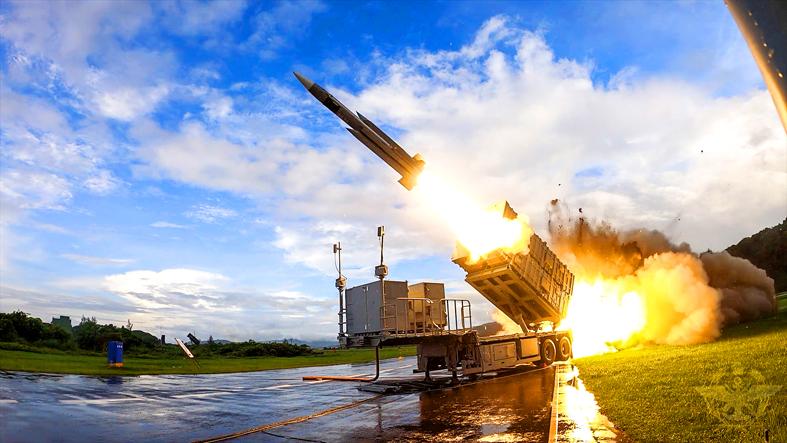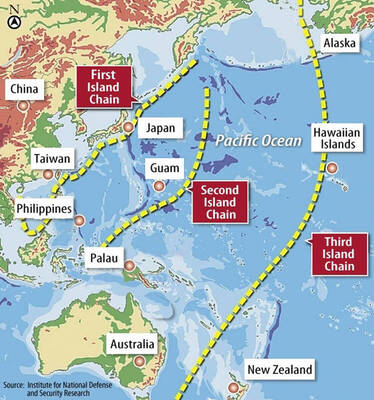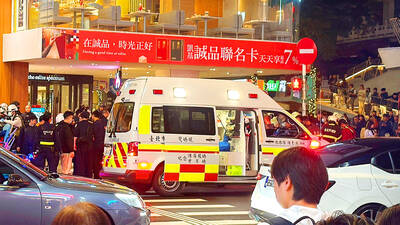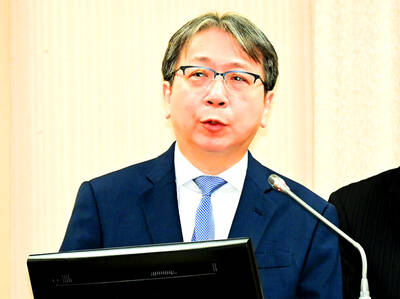The Ministry of National Defense plans to counter the Chinese navy by producing more than 1,000 anti-ship missiles over the next five years, a defense official familiar with the matter said yesterday.
The comments came after China’s People’s Liberation Army Navy began a series of military drills in a simulated naval blockade of Taiwan proper following a visit to Taipei by US House of Representatives Speaker Nancy Pelosi.
Although China has in the past few years rapidly produced many warships and added them to its navy, these large vessels are more suited for warfare on the open sea than in the narrow confines of the Taiwan Strait, the official said on condition of anonymity.

Photo: EPA-EFE
Taiwan’s radar systems and anti-ship missile units can track large or medium-sized warships with relative ease in waters near its stations, a capability proven by their performance during China’s naval drills and other activities, the official said.
China’s 052-class guided-missile destroyers can be rendered combat ineffective or sunk after being struck by four anti-ship missiles, while two missiles should suffice for smaller craft, the official said, citing analysts.
Torpedoes that strike a ship below its waterline would cause greater damage than missiles, the official said.
As the Sea-Air Combat Power Improvement Plan enters into effect, Taiwan is initiating the mass production of locally designed missiles from this year to 2026, the source said.
Under the five-year plan, the Chungshan Institute of Science and Technology would manufacture 70 Hsiung Feng III/IIIE missiles per year, while 131 Hsiung Feng II and Hsiung Sheng missiles can be produced every year by sharing an assembly line, the source said.
In addition, Taiwan is expected to receive 100 Harpoon missile launchers and 400 missiles from the US, which would be deployed in conjunction with domestically made systems, the source said.
Taiwan’s ability to deploy multiple types of missiles would improve the kill probability of strikes on ships, ensuring that China would pay a heavy price for trying to invade, the official said.

The US government has signed defense cooperation agreements with Japan and the Philippines to boost the deterrence capabilities of countries in the first island chain, a report by the National Security Bureau (NSB) showed. The main countries on the first island chain include the two nations and Taiwan. The bureau is to present the report at a meeting of the legislature’s Foreign Affairs and National Defense Committee tomorrow. The US military has deployed Typhon missile systems to Japan’s Yamaguchi Prefecture and Zambales province in the Philippines during their joint military exercises. It has also installed NMESIS anti-ship systems in Japan’s Okinawa

TRAGEDY STRIKES TAIPEI: The suspect died after falling off a building after he threw smoke grenades into Taipei Main Station and went on a killing spree in Zhongshan A 27-year-old suspect allegedly threw smoke grenades in Taipei Main Station and then proceeded to Zhongshan MRT Station in a random killing spree that resulted in the death of the suspect and two other civilians, and seven injured, including one in critical condition, as of press time last night. The suspect, identified as a man surnamed Chang Wen (張文), allegedly began the attack at Taipei Main Station, the Taipei Fire Department said, adding that it received a report at 5:24pm that smoke grenades had been thrown in the station. One man in his 50s was rushed to hospital after a cardiac arrest

‘WIN-WIN’: The Philippines, and central and eastern European countries are important potential drone cooperation partners, Minister of Foreign Affairs Lin Chia-lung said Minister of Foreign Affairs Lin Chia-lung (林佳龍) in an interview published yesterday confirmed that there are joint ventures between Taiwan and Poland in the drone industry. Lin made the remark in an exclusive interview with the Chinese-language Liberty Times (the Taipei Times’ sister paper). The government-backed Taiwan Excellence Drone International Business Opportunities Alliance and the Polish Chamber of Unmanned Systems on Wednesday last week signed a memorandum of understanding in Poland to develop a “non-China” supply chain for drones and work together on key technologies. Asked if Taiwan prioritized Poland among central and eastern European countries in drone collaboration, Lin

ON ALERT: Taiwan’s partners would issue warnings if China attempted to use Interpol to target Taiwanese, and the global body has mechanisms to prevent it, an official said China has stationed two to four people specializing in Taiwan affairs at its embassies in several democratic countries to monitor and harass Taiwanese, actions that the host nations would not tolerate, National Security Bureau (NSB) Director-General Tsai Ming-yen (蔡明彥) said yesterday. Tsai made the comments at a meeting of the legislature’s Foreign Affairs and National Defense Committee, which asked him and Minister of National Defense Wellington Koo (顧立雄) to report on potential conflicts in the Taiwan Strait and military preparedness. Democratic Progressive Party (DPP) Legislator Michelle Lin (林楚茵) expressed concern that Beijing has posted personnel from China’s Taiwan Affairs Office to its